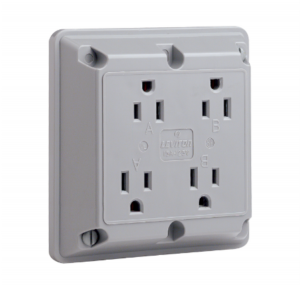2021 Changes in the Canadian Electrical Code
 A series by guest writer Steve Douglas, Senior Technical Codes Specialist, QPS
A series by guest writer Steve Douglas, Senior Technical Codes Specialist, QPS
This is the first of a series of articles detailing significant changes for the 2021 Canadian Electrical Code Part I (CE Code) that may impact electrical equipment manufacturers. A full copy of the CE Code is available at https://www.csagroup.org/store/ .
In Section 8 of the CE Code Rule 8-304 Maximum number of outlets per circuit is one of the more significant code changes that may result in changing current wiring practices in Canada. Subrule 4) covering fixed multi-outlet assemblies has not changed, but the revised Subrules 1) to 3) now reads:
“1) Except as permitted by other Rules of this Code, the maximum number of outlets on any 2-wire branch circuit shall not exceed the following:
- a) 12 outlets for a 15 A branch circuit where the fused switch or circuit breaker is marked for continuous operation at 80%;
- b) 15 outlets for a 15 A branch circuit where the fused switch or circuit breaker is marked for continuous operation at 100%;
- c) 16 outlets for a 20 A branch circuit where the fused switch or circuit breaker is marked for continuous operation at 80%; and
- d) 20 outlets for a 20 A branch circuit where the fused switch or circuit breaker is marked for continuous operation at 100%.
2) Except as permitted by Subrule 3), when a receptacle is used as an outlet for the application of Subrule 1), it shall be considered as
- a) 1 outlet per duplex receptacle;
- b) 1.5 outlets per triplex receptacle; and
- c) 2 outlets per quadruplex receptacle.
3) Where the connected load is known, the number of outlets shall be permitted to exceed the maximum number permitted in Subrule 1), provided that the load current does not exceed the continuous operation marking on the overcurrent device protecting the circuit.
4)…”
In previous codes the maximum number of outlets on a 15 A or 20 A branch circuit was limited to 12 A. The rule now recognizes a difference between a 15 A and 20 A branch circuit, and the use of circuit breakers marked for continuous operation at 100% for these branch circuits. This has the possibility of increasing the number of outlets for a 20 A branch circuit with a branch circuit overcurrent device marked for continuous operation at 100% from 12 to 20 outlets. This may increase the demand for 20 A circuit breakers, #12 cables and 5-20R (T-slot) receptacles.
In addition, the change regarding the number of outlets on a branch circuit Subrule 2) has removed the 1 A per outlet consideration and now provides clear direction when triplex and quadruplex receptacles are installed.

The above image is a quadruplex receptacle that would be considered two outlets.
Photo courtesy of Leviton Canada.
For more information or clarification on this topic, please contact Steve Douglas at SDouglas@qps.ca
—
Steve Douglas is the Senior Technical Codes Specialist for QPS Evaluation Services and is an IAEI International Past President. In addition, Steve is the Immediate Past Vice Chair of the CE Code Part I, Chair of CE Code Part I Subcommittees for Section 2, 12, and 84, and a member on Sections 8, 40, 64, 68, 76, 78 and Appendix A. In addition, Steve is the Chair of the CSA Subcommittees for Standards C22.2 No. 273 Cablebus, C22.2 No. 327 HDPE Conduit, C22.6 No. 1, Electrical Inspection Code for Existing Residential Occupancies committee, SPE-1000 Working Group the Past Chair of the Technical Committee on Wind Turbines, and a member on committees for the Objective Based Industrial Electrical Code, Safety Management Systems, Energy Storage Systems, Solar Photovoltaic Modules, Industrial control panels and assemblies, Industrial Machinery, Photovoltaic Cable, Fuel Cells, Wind Turbines, Distribution transformers, Outlet Boxes, and Wiring Fittings Hardware and Positioning Devices.